West End Workbench
Moderators: 52D, Tom F, Rlangham, Atlantic 3279, Blink Bonny, Saint Johnstoun, richard
-
john coffin
- LNER V2 2-6-2 'Green Arrow'
- Posts: 1101
- Joined: Mon Sep 19, 2011 12:24 am
Re: West End Workbench
As usual Jonathan, a nice build, and glad to be part of it.
If you can let me have some extra details, I will incorporate them in
the updated instructions.
Paul
If you can let me have some extra details, I will incorporate them in
the updated instructions.
Paul
- Atlantic 3279
- LNER A4 4-6-2 'Streak'
- Posts: 6658
- Joined: Fri Jun 26, 2009 9:51 am
- Location: 2850, 245
Re: West End Workbench
Nice to see a variety of LNER J classes of GN origin accurately represented in model form, if only so that those show-goers whose blinkers limit their knowledge to what they saw in the late fifties and early sixties can wrongly call them all J6s...
Most subjects, models and techniques covered in this thread are now listed in various categories on page1
Dec. 2018: Almost all images that disappeared from my own thread following loss of free remote hosting are now restored.
Dec. 2018: Almost all images that disappeared from my own thread following loss of free remote hosting are now restored.
-
jwealleans
- LNER A4 4-6-2 'Streak'
- Posts: 4303
- Joined: Wed Oct 25, 2006 8:46 am
Re: West End Workbench
Awaiting the last bits and bobs on the J5, I've moved on to other things just to keep the fingers busy.
GN brake van has started through the paint shop.
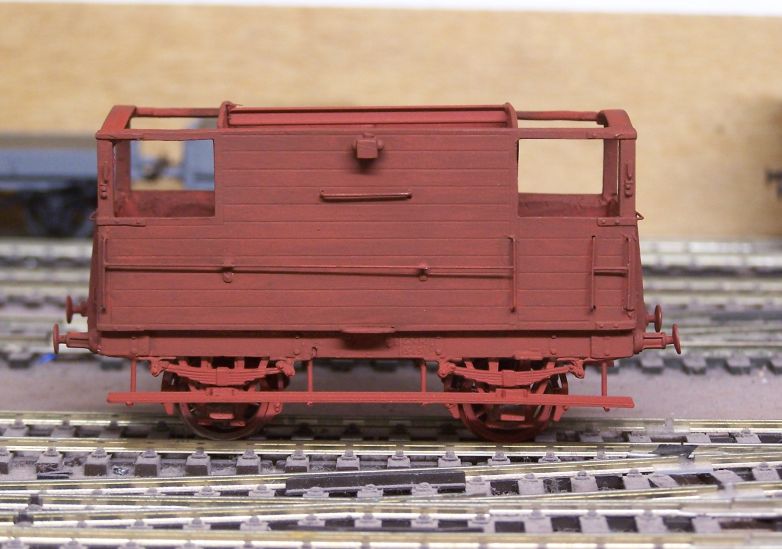
I've started on a project I think I've mentioned before - the East Suffolk line's only named train (post war), The Easterling. This ran from Liverpool Street to Yarmouth South Town and Lowestoft. I was sent a consist from the very early 1950s - apologies to whomever sent it, I can't now remember who it was. It may have been Andy Rush. At this time the train left Liverpool Street at 11:03 (10:33 SO) and consisted of:
BTK(3) - D41
2 TK - D23
CK (2 1/2-5) - D7
CK (3 1/2-4) - D130
RF
TO
This was the Yarmouth portion and the RF/TO are noted as being GE diagrams.
CK (2 1/1-5) - D7
BTK(5) - D37/A
TK (8) - D23 (SO)
These last 3 vehicles ran to Lowestoft Central.
I already have a GE RF from D & S and had started to gather up the other diagrams. A couple of year ago Dave Scott was disposing of some Gresleys and I managed to obtain 2 D23 and a D7 from him all but complete. I also had the RTO, a GE D431, from Bill Bedford. That was what I put together over the last couple of days.

I've used almost all of what Bill supplied here; I now need some brass angle for the cornice and tube to make queenposts so there are some underframe bits, including battery boxes, still to add. It's also worth noting that this vehicle, 6114, was rebuilt by the LNER in 1937 with plain panelling, so it's not accurate for the postwar period. It'll fill the gap until I can source a closer match and will be finished in teak so I can reuse elsewhere if it is replaced. It went together nicely, I have to say. I do not believe this kit is still available, though.
This is the current state of play with the whole intended set:

The leading BTK is available from RDEB and that'll be the next to build. After that if I work sequentially, it'll be the D130 CK, which can be had from MJT. The last two vehicles, the other D7 and D37A, I already have sides for from Bill, so they'll be to assemble onto an MJT base.
This was a B1 or B17 working, so there will be some trial and test required to produce something which one of my locos can move, but there is the scope to drop one or two TKs if it starts to get too weighty. I'm not sure when Wickham Market is next due out either, so I don't have a firm deadline for this, but it gives me something to work to in among building whatever else I fancy.
GN brake van has started through the paint shop.

I've started on a project I think I've mentioned before - the East Suffolk line's only named train (post war), The Easterling. This ran from Liverpool Street to Yarmouth South Town and Lowestoft. I was sent a consist from the very early 1950s - apologies to whomever sent it, I can't now remember who it was. It may have been Andy Rush. At this time the train left Liverpool Street at 11:03 (10:33 SO) and consisted of:
BTK(3) - D41
2 TK - D23
CK (2 1/2-5) - D7
CK (3 1/2-4) - D130
RF
TO
This was the Yarmouth portion and the RF/TO are noted as being GE diagrams.
CK (2 1/1-5) - D7
BTK(5) - D37/A
TK (8) - D23 (SO)
These last 3 vehicles ran to Lowestoft Central.
I already have a GE RF from D & S and had started to gather up the other diagrams. A couple of year ago Dave Scott was disposing of some Gresleys and I managed to obtain 2 D23 and a D7 from him all but complete. I also had the RTO, a GE D431, from Bill Bedford. That was what I put together over the last couple of days.

I've used almost all of what Bill supplied here; I now need some brass angle for the cornice and tube to make queenposts so there are some underframe bits, including battery boxes, still to add. It's also worth noting that this vehicle, 6114, was rebuilt by the LNER in 1937 with plain panelling, so it's not accurate for the postwar period. It'll fill the gap until I can source a closer match and will be finished in teak so I can reuse elsewhere if it is replaced. It went together nicely, I have to say. I do not believe this kit is still available, though.
This is the current state of play with the whole intended set:

The leading BTK is available from RDEB and that'll be the next to build. After that if I work sequentially, it'll be the D130 CK, which can be had from MJT. The last two vehicles, the other D7 and D37A, I already have sides for from Bill, so they'll be to assemble onto an MJT base.
This was a B1 or B17 working, so there will be some trial and test required to produce something which one of my locos can move, but there is the scope to drop one or two TKs if it starts to get too weighty. I'm not sure when Wickham Market is next due out either, so I don't have a firm deadline for this, but it gives me something to work to in among building whatever else I fancy.
-
jwealleans
- LNER A4 4-6-2 'Streak'
- Posts: 4303
- Joined: Wed Oct 25, 2006 8:46 am
Re: West End Workbench
Waiting for bits for the RTO, I made a start on one of the acquired carriages this evening. Although assembled, they need a bit of work doing - and undoing - before they can be finished. This is the starting point (they're all built to pretty much the same point):

First - and absolutely no disrespect intended to Dave, who has built these well and entirely as they were intended to be built - why do people insist on producing carriages which have removable roofs instead of splitting at the solebar? I'm sorry if you've read this before, but it baffles me. It baffles me even more that the professionals do it when it makes it so much harder to finish them. You'll see in the images below, the minimal space available to paint and finish the interiors or make the changes I want to make here as well as the roof join being much harder to conceal. I was looking at an ECJS vehicle at ground level last week and it's quite apparent that they come apart at the solebar - you can see daylight clear across the thing under the body - so why not have the join where it is on the prototype instead of where it's more obvious and harder to conceal? Dave, bless him, had at least made the roof bolt on rather than gluing it as a lot of builders do. Look at the last picture in this post and imagine what an ordeal it's going to be getting the handrail along the corridor windows. It's all so unnecessarily hard. Don't even get me onto having to prise off a glued roof to replace some glazing which has fallen out, instead of unscrewing the body.
Right, rant over. What do we need to do? The corridor connectors need to come off. They'd have had to be removed for painting anyway, but I've tried to use them before and when placed against another similarly fitted vehicle they're simply too bulky and stop them coupling easily and moving against each other. All the door and commode handles also need to come back off. I know Dave intended these to be finished in teak, but for me they'll make it impossible to mask for blood and custard. I'm not sure how he'd have lined behind the commode handles anyway. The roof needs vent and tank filler holes drilling and destination board holders as well as alarm gear and the rain deflectors. Then there's the bogies and coupling provision. I'll go into those in more detail.
These were built to EM and fitted with what I think Dave said are Mitchell-Pendleton bogies.
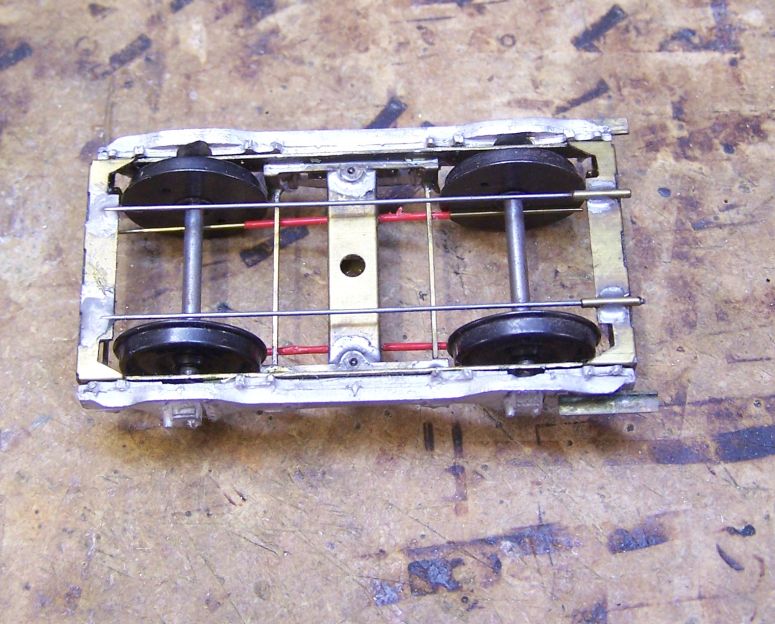
I've had a few carriages with these on from him and had just discarded them (after robbing the MJT sides off a few). However I had been messing about with one one day and was struck by how freely it ran. Given what I said yesterday about this being a heavy train for a (likely Hornby) 4-6-0, I decided to see whether they would regauge to OO.
As you can see above, the bogie has two pairs of wires above and below the frames. These need to go between the wheelsets. The top ones were not a problem, but viewed from underneath it was obvious that OO wheels would foul the retaining wires.

These bogies have two sets of springing: the carriage rests and swivels on the top pair of wires, while each wheel has a sprung bearing which slides up and down in slots in the bogie frame. The bottom wires simply retain the wheelsets, so repositioning them wouldn't have any unforeseen effects on the mechanics of the bogie. I removed the wires from the holes in the bolster and added two short pieces of tube inboard where the shape of the etch nicely located them. Pleasingly, this assembly works and they're beautifully free running. You can see the amended bogie below.

Bogies dealt with, it was time to consider couplings. There was a slot in the buffer beam of each vehicle, presumably for whatever system Dave intended to employ. I use Bill Bedford's etched couplings for carriages (formerly available from Eileen's, but no longer supplied) which requires an 8BA nut soldered to the floor just behind the end of the carriage. Two issues with that:
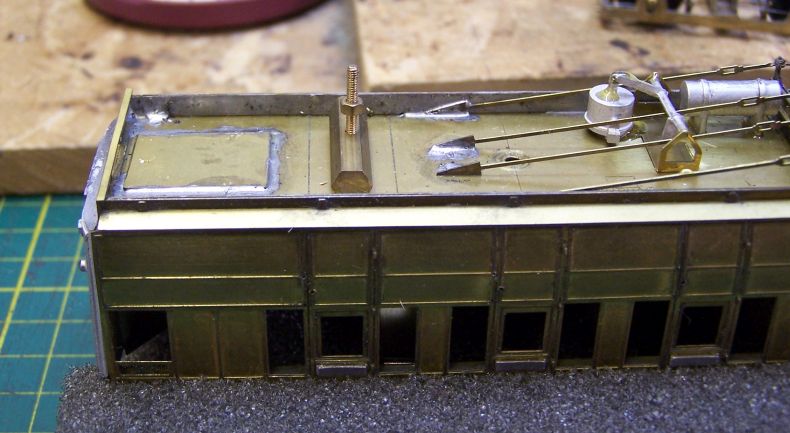
From underneath, a second thickness of brass has been added to the floor where I want to drill through for the nut (the brass hex is the mount for the bogie).

From above you can see how awkward it is to get the iron in and the complete impossibility of going right round the nut with it. In the end I drilled then enlarged the hole and tinned round it first, then positioning the nut and melting it into place. I managed not to melt the end casting or hit any of the whitemetal vent hoods with the iron, but I have two more to do so there's still time.
Incidentally, I now gather that these bogies are still available from Dave Bradwell. I'm tempted to use them again, but we'll see how this set runs once complete.

First - and absolutely no disrespect intended to Dave, who has built these well and entirely as they were intended to be built - why do people insist on producing carriages which have removable roofs instead of splitting at the solebar? I'm sorry if you've read this before, but it baffles me. It baffles me even more that the professionals do it when it makes it so much harder to finish them. You'll see in the images below, the minimal space available to paint and finish the interiors or make the changes I want to make here as well as the roof join being much harder to conceal. I was looking at an ECJS vehicle at ground level last week and it's quite apparent that they come apart at the solebar - you can see daylight clear across the thing under the body - so why not have the join where it is on the prototype instead of where it's more obvious and harder to conceal? Dave, bless him, had at least made the roof bolt on rather than gluing it as a lot of builders do. Look at the last picture in this post and imagine what an ordeal it's going to be getting the handrail along the corridor windows. It's all so unnecessarily hard. Don't even get me onto having to prise off a glued roof to replace some glazing which has fallen out, instead of unscrewing the body.
Right, rant over. What do we need to do? The corridor connectors need to come off. They'd have had to be removed for painting anyway, but I've tried to use them before and when placed against another similarly fitted vehicle they're simply too bulky and stop them coupling easily and moving against each other. All the door and commode handles also need to come back off. I know Dave intended these to be finished in teak, but for me they'll make it impossible to mask for blood and custard. I'm not sure how he'd have lined behind the commode handles anyway. The roof needs vent and tank filler holes drilling and destination board holders as well as alarm gear and the rain deflectors. Then there's the bogies and coupling provision. I'll go into those in more detail.
These were built to EM and fitted with what I think Dave said are Mitchell-Pendleton bogies.

I've had a few carriages with these on from him and had just discarded them (after robbing the MJT sides off a few). However I had been messing about with one one day and was struck by how freely it ran. Given what I said yesterday about this being a heavy train for a (likely Hornby) 4-6-0, I decided to see whether they would regauge to OO.
As you can see above, the bogie has two pairs of wires above and below the frames. These need to go between the wheelsets. The top ones were not a problem, but viewed from underneath it was obvious that OO wheels would foul the retaining wires.

These bogies have two sets of springing: the carriage rests and swivels on the top pair of wires, while each wheel has a sprung bearing which slides up and down in slots in the bogie frame. The bottom wires simply retain the wheelsets, so repositioning them wouldn't have any unforeseen effects on the mechanics of the bogie. I removed the wires from the holes in the bolster and added two short pieces of tube inboard where the shape of the etch nicely located them. Pleasingly, this assembly works and they're beautifully free running. You can see the amended bogie below.

Bogies dealt with, it was time to consider couplings. There was a slot in the buffer beam of each vehicle, presumably for whatever system Dave intended to employ. I use Bill Bedford's etched couplings for carriages (formerly available from Eileen's, but no longer supplied) which requires an 8BA nut soldered to the floor just behind the end of the carriage. Two issues with that:

From underneath, a second thickness of brass has been added to the floor where I want to drill through for the nut (the brass hex is the mount for the bogie).

From above you can see how awkward it is to get the iron in and the complete impossibility of going right round the nut with it. In the end I drilled then enlarged the hole and tinned round it first, then positioning the nut and melting it into place. I managed not to melt the end casting or hit any of the whitemetal vent hoods with the iron, but I have two more to do so there's still time.
Incidentally, I now gather that these bogies are still available from Dave Bradwell. I'm tempted to use them again, but we'll see how this set runs once complete.
-
jwealleans
- LNER A4 4-6-2 'Streak'
- Posts: 4303
- Joined: Wed Oct 25, 2006 8:46 am
Re: West End Workbench
Multiple packages arrived this week so we were able to progress on multiple fronts.

J5 now all but done and ready for final filling and fettling before paint. The balance weights are to add and I need to make a handbrake upstand for the tender. Tonight I reassembled the frames ready for pickups to be fitted and there'll be a few days of test running now i have the facility. The mech has had a few hours on the rolling road this evening.
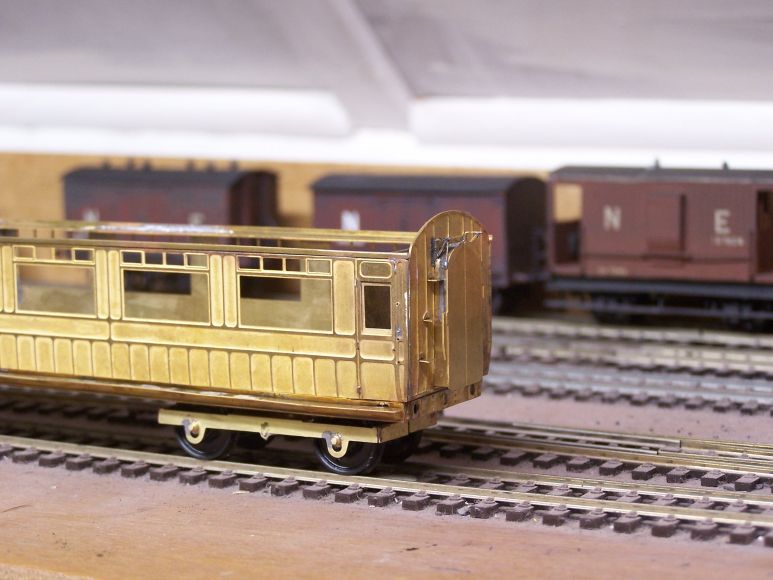
I fitted the corridor connectors to the RTO and added the little gallows brackets which are visible in the photo I have. Incidentally, does anyone know why this still had gas cylinders even after conversion to electric light? There was no pantry, so was it a supplementary supply to the kitchen car?

The first D23 also detailed and primed. I've added roof vents and fillers, rain deflectors, buffers, the vac pipe along the solebar, jumper cables and bogie steps. This will be ready for paint soon, so I'll have to see what spray cans I have which still work. What are people using for BR cream these days? I gather Vauxhall Gazelle Beige is not easily available.

J5 now all but done and ready for final filling and fettling before paint. The balance weights are to add and I need to make a handbrake upstand for the tender. Tonight I reassembled the frames ready for pickups to be fitted and there'll be a few days of test running now i have the facility. The mech has had a few hours on the rolling road this evening.

I fitted the corridor connectors to the RTO and added the little gallows brackets which are visible in the photo I have. Incidentally, does anyone know why this still had gas cylinders even after conversion to electric light? There was no pantry, so was it a supplementary supply to the kitchen car?

The first D23 also detailed and primed. I've added roof vents and fillers, rain deflectors, buffers, the vac pipe along the solebar, jumper cables and bogie steps. This will be ready for paint soon, so I'll have to see what spray cans I have which still work. What are people using for BR cream these days? I gather Vauxhall Gazelle Beige is not easily available.
-
Darryl Tooley
- NBR J36 0-6-0
- Posts: 107
- Joined: Wed Oct 30, 2013 9:21 pm
- Location: Briston, UK
Re: West End Workbench
Yes.so was it a supplementary supply to the kitchen car?
D
-
jwealleans
- LNER A4 4-6-2 'Streak'
- Posts: 4303
- Joined: Wed Oct 25, 2006 8:46 am
Re: West End Workbench
Cheers, Darryl. Couldn't see what else they might be for.
Had a good long session today so I tackled the longest job - cut out, formed and fitted the roof to the RTO. Always a fiddly slow job but worth it in the end as you get a really solid structure out of the body.

I put brass angle along the top of the sides to have something to solder to (and to hide any raggy edges). The sheet is then cut, annealed, rolled and attached. Vent holes have been drilled, end handrails, alarm gear, solebar vac pipe, trussing, battery boxes, buffer stocks and V hangers attached. Soldering is about done on this now so I can make a start on the plastic bits.
Had a good long session today so I tackled the longest job - cut out, formed and fitted the roof to the RTO. Always a fiddly slow job but worth it in the end as you get a really solid structure out of the body.

I put brass angle along the top of the sides to have something to solder to (and to hide any raggy edges). The sheet is then cut, annealed, rolled and attached. Vent holes have been drilled, end handrails, alarm gear, solebar vac pipe, trussing, battery boxes, buffer stocks and V hangers attached. Soldering is about done on this now so I can make a start on the plastic bits.
-
jwealleans
- LNER A4 4-6-2 'Streak'
- Posts: 4303
- Joined: Wed Oct 25, 2006 8:46 am
Re: West End Workbench
I have a number of dismantled and part painted carriages lying around the workshop now, but none really in a state to be worth photographing. We also await a delivery of paint.
Being a tidy minded individual, I have gone back to the front of the train and made a start on the first vehicle, a 52'6" BTK. For this I've used the RDEB kit rather than the Kirk as it's readily available.
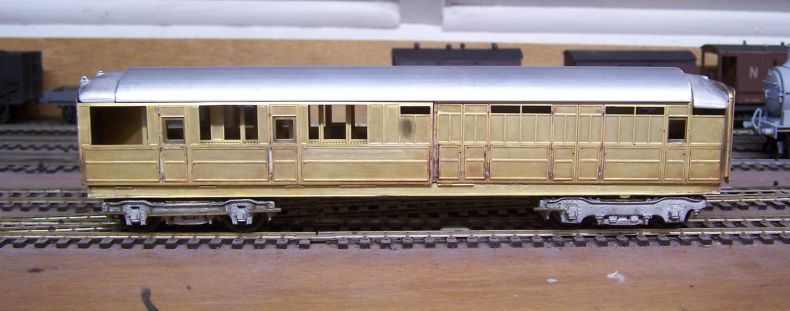
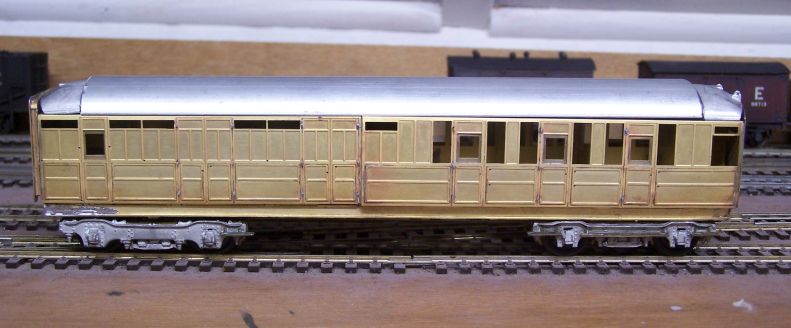
These are a basic kit and in this one there isn't even a floor. By the time it's completed it'll be a real bitsa - RDEB sides and ends, Comet floor, MJT roof and underframe bits, Pendleton bogies, Bill Bedford coupling. It must be one of Rupert's older kits - the etches are dated 1995 - and although it had hinge holes, there are none for door handles and grab rails. The instructions cover it all adequately, though and do make it clear what you need to add.
For now the body soldering is complete, just the roof to mark, drill and fix and then the underframe to populate.
Being a tidy minded individual, I have gone back to the front of the train and made a start on the first vehicle, a 52'6" BTK. For this I've used the RDEB kit rather than the Kirk as it's readily available.


These are a basic kit and in this one there isn't even a floor. By the time it's completed it'll be a real bitsa - RDEB sides and ends, Comet floor, MJT roof and underframe bits, Pendleton bogies, Bill Bedford coupling. It must be one of Rupert's older kits - the etches are dated 1995 - and although it had hinge holes, there are none for door handles and grab rails. The instructions cover it all adequately, though and do make it clear what you need to add.
For now the body soldering is complete, just the roof to mark, drill and fix and then the underframe to populate.
- Dave
- LNER A4 4-6-2 'Streak'
- Posts: 1733
- Joined: Sat Nov 13, 2010 9:33 pm
- Location: Centre of the known universe York
Re: West End Workbench
Tidy minded Jonathan.........have I missed something all these years
-
jwealleans
- LNER A4 4-6-2 'Streak'
- Posts: 4303
- Joined: Wed Oct 25, 2006 8:46 am
Re: West End Workbench
I didn't say clean, only tidy.
-
jwealleans
- LNER A4 4-6-2 'Streak'
- Posts: 4303
- Joined: Wed Oct 25, 2006 8:46 am
Re: West End Workbench
In case anyone thinks I've forgotten about it, the J5 took its first run round a layout tonight after having pickups fitted.
https://www.youtube.com/watch?v=JtX77nfOma8
https://www.youtube.com/watch?v=JtX77nfOma8
- Atlantic 3279
- LNER A4 4-6-2 'Streak'
- Posts: 6658
- Joined: Fri Jun 26, 2009 9:51 am
- Location: 2850, 245
Re: West End Workbench
In proper pre-1960s monochrome too.
Most subjects, models and techniques covered in this thread are now listed in various categories on page1
Dec. 2018: Almost all images that disappeared from my own thread following loss of free remote hosting are now restored.
Dec. 2018: Almost all images that disappeared from my own thread following loss of free remote hosting are now restored.
-
jwealleans
- LNER A4 4-6-2 'Streak'
- Posts: 4303
- Joined: Wed Oct 25, 2006 8:46 am
Re: West End Workbench
Only because I can't remember how I managed sepia on the videos from Sir's a couple of years ago.
- billbedford
- GNSR D40 4-4-0
- Posts: 202
- Joined: Sun Jan 17, 2016 10:28 am
Re: West End Workbench
But then you would need opening doors to get the people inside...jwealleans wrote: ↑Mon Nov 08, 2021 11:07 pm First - and absolutely no disrespect intended to Dave, who has built these well and entirely as they were intended to be built - why do people insist on producing carriages which have removable roofs instead of splitting at the solebar?
I've done some test prints of roofs. The advantage of these thin printed roofs is that they have enough 'spring' to enable them to be clipped into the coach body. The way this is achieved is by having a wire soldered to the top inside edge of the bodyside and a groove printed in the roof under the cornice moulding. I'm still trying to decide what size wire to suggest, but 0.7 or 1mm seems about right.
- Atlantic 3279
- LNER A4 4-6-2 'Streak'
- Posts: 6658
- Joined: Fri Jun 26, 2009 9:51 am
- Location: 2850, 245
Re: West End Workbench
All very well I suppose, providing that the designer, manufacturer and kit builder have all managed to maintain perfectly straight edges to the tops of the sides and to the edges of the roof, complete with exactly the correct profile to the clip-joint, all completely free of any unintended minor notches and lumps, otherwise gaps or bulges may appear...
Most subjects, models and techniques covered in this thread are now listed in various categories on page1
Dec. 2018: Almost all images that disappeared from my own thread following loss of free remote hosting are now restored.
Dec. 2018: Almost all images that disappeared from my own thread following loss of free remote hosting are now restored.